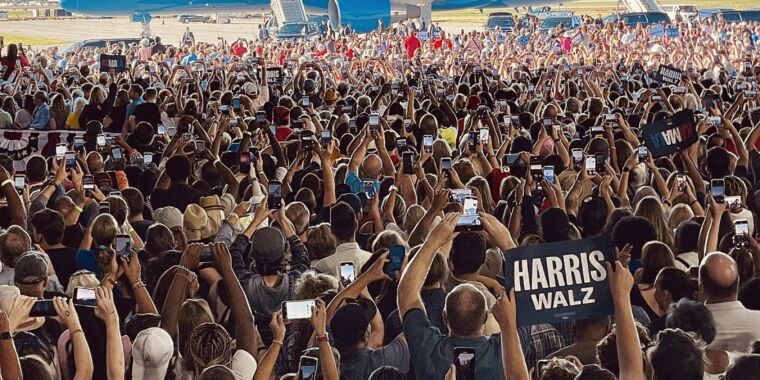Donald Trump may have coined a new term in his latest false attack on Kamala Harris’ presidential campaign. In a pair of posts on Truth Social over the weekend, the former president said that Vice President Kamala Harris “A.I.’d” photos of a huge crowd that showed up to see her speak at a Detroit airport campaign rally last week.
“There was nobody at the plane, and she ‘A.I.’d’ it, and showed a massive ‘crowd’ of so-called followers, BUT THEY DIDN’T EXIST!” Trump wrote. “She’s a CHEATER. She had NOBODY waiting, and the ‘crowd’ looked like 10,000 people! Same thing is happening with her fake ‘crowds’ at her speeches.”
The Harris campaign responded with its own post saying that the image is “an actual photo of a 15,000-person crowd for Harris-Walz in Michigan.”
Aside from the novel use of “AI” as a verb, Trump’s post marks the first time, that we know of, that a US presidential candidate has personally raised the specter of AI-generated fakery by an opponent (rather than by political consultants or random social media users). The accusations, false as they are, prey on widespread fears and misunderstandings over the trustworthiness of online information in the AI age.
It would be nice to think that we could just say Trump’s claims here are categorically false and leave it at that. But as artificial intelligence tools become increasingly good at generating photorealistic images, it’s worth outlining the many specific ways we can tell that Harris’ crowd photos are indeed authentic. Consider this a guide for potential techniques you can use the next time you come across accusations that some online image has been “A.I.’d” to fool you.
Context and sourcing
By far the easiest way to tell Harris’ crowds are real is from the vast number of corroborating sources showing those same crowds. Both the AP and Getty have numerous shots of the rally crowd from multiple angles, as do journalists and attendees who were at the event. Local news sources posted video of the crowds at the event, as did multiple attendees on the ground. Reporters from multiple outlets reported directly on the crowds in their accounts: Local outlet MLive estimated the crowd size at 15,000, for instance, while The New York Times noted that the event was “witnessed by thousands of people and news outlets, including The New York Times, and the number of attendees claimed by her campaign is in line with what was visible on the ground.”
The Harris/Walz rally in Detroit is buzzing after a performance from the Detroit Youth Choir. #Michigan pic.twitter.com/sdFQvHhG3I
— Nora Eckert (@NoraEckert) August 7, 2024
Suffice it to say that this mountain of evidence from direct sources weighs more heavily than marked-up images from conservative commentators like Chuck Callesto and Dinesh D’Souza, both of whom have been caught spreading election disinformation in the past.
When it comes to accusations of AI fakery, the more disparate sources of information you have, the better. While a single source can easily generate a plausible-looking image of an event, multiple independent sources showing the same event from multiple angles are much less likely to be in on the same hoax. Photos that line up with video evidence are even better, especially since creating convincing long-form videos of humans or complex scenes remains a challenge for many AI tools.
It’s also important to track down the original source of whatever alleged AI image you’re looking at. It’s incredibly easy for a social media user to create an AI-generated image, claim it came from a news report or live footage of an event, then use obvious flaws in that fake image as “evidence” that the event itself was faked. Links to original imagery from an original source’s own website or verified account are much more reliable than screengrabs that could have originated anywhere (and/or been modified by anyone).

